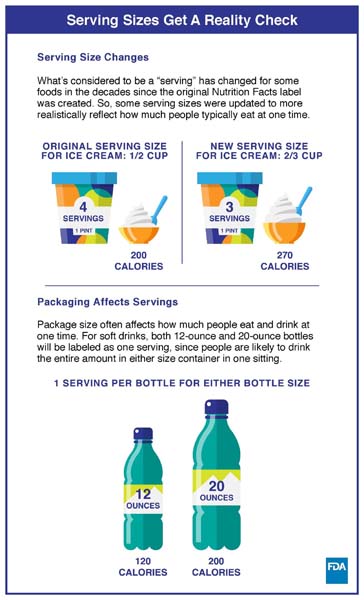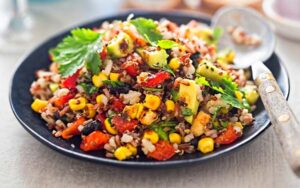Food Portions & Choosing Just Enough for You
To reach or stay at a healthy weight, how much you eat is just as important as what you eat. Do you know how much food is enough for you? The information below explains portions and servings, and provides tips to help you eat just enough for you.
What is the difference between a portion and a serving?
A portion is how much food you choose to eat at one time, whether in a restaurant, from a package, or at home. A serving, or serving size, is the amount of food listed on a product’s Nutrition Facts label, or food label.
Different products have different serving sizes. Sizes can be measured in cups, ounces, grams, pieces, slices, or numbers—such as three crackers. Depending on how much you choose to eat, your portion size may or may not match the serving size.
To see how many servings a container has, look at the top of the label. “Servings per container” is listed right above “Serving size.” In the example below, a frozen lasagna serving size is 1 cup. But the container has four servings. If you want to eat 2 cups—or half the package—you’d be eating two servings.
Do a little math to find out how many calories you would really be getting.
- 1 serving = 280 calories
- 2 servings = 280 × 2 = 560 calories
In this case, eating two servings would mean getting twice the calories—and other nutrients—that are listed on the food label.
Figure 1. Nutrition Facts label (Sample Nutrition Facts label for frozen lasagna, Source: U.S. Food and Drug Administration)

How have recommended serving sizes changed?
The U.S. Food and Drug Administration (FDA) changed some food and beverage serving sizes so the labels more closely match how much we typically eat and drink. As a result of recent updates to the Nutrition Facts label, some serving sizes on food labels may be larger or smaller than they were before (see Figure 2 below). For instance, a serving size of ice cream used to be 1/2 cup. Now it’s 2/3 cup. A serving size of yogurt used to be 8 ounces. Now it’s 6 ounces.
Remember: The serving size on a label is not a recommendation of how much you should eat or drink.
Figure 2. FDA serving size changes: Some serving sizes on food labels may be larger or smaller than they were before. (Source: U.S. Food and Drug Administration)

How much should I eat?
The serving size on a food label may be more than or less than the amount you should eat. That’s because how many calories you need each day to maintain your weight or lose weight may depend on
- your age
- your current weight and height
- your metabolism
- whether you’re male or female
- how active you are
For example, if you’re a 150-pound woman whose main physical activity is a short walk once a week, you’ll need fewer calories than a woman about your size who engages in intense physical activity, such as running, several times a week.
To help you figure out how many calories are just enough for you, check out the following resources.
- The Dietary Guidelines for Americans, 2020-2025 (https://www.dietaryguidelines.gov) can give you an idea of how many calories you may need each day based on your age, sex, and physical activity level.
- The Body Weight Planner(https://www.niddk.nih.gov/health-information/weight-management/body-weight-planner) tool helps you make your own calorie and physical activity plans to reach and maintain your goal weight.
- The MyPlate Plan(https://www.myplate.gov/myplate-plan) helps you form a healthy eating plan with the amounts of food and beverages that are right for you.
How can the Nutrition Facts food label help me?
The food label has other useful information about what is in one food serving, such as:
- Total fat. For example, one serving of the food item shown in Figure 1 above has 4.5 grams of saturated fat and 0 grams of trans fat.
- Added sugars. The Dietary Guidelines for Americans, 2020–2025 recommends that less than 10% of your total daily calories should come from added sugars.
- The Dietary Guidelines for Americans, 2020–2025 recommends limiting sodium to 2,300 milligrams per day, or even less for children younger than age 14.
- Other nutrients. Americans don’t always get enough vitamin D and potassium. That’s why the updated food label includes serving information for both these nutrients. Because most Americans generally do get enough vitamin A and vitamin C, these nutrients are no longer included on the food label. However, food makers may include them if they choose.
How can I manage food portions at home?
You don’t need to measure and count everything you eat or drink for the rest of your life. You may only want to do so long enough to learn typical serving and portion sizes. Try these tips to control portions at home.
- Take one serving according to the food label and eat it off a plate instead of straight out of the box or bag.
- Avoid eating in front of the TV, while driving or walking, or while you are busy with other activities.
- Focus on what you are eating, chew your food well, and fully enjoy the smell and taste of your food.
- Eat slowly so your brain has time to realize your stomach is full, which may take at least 15 minutes.
- Use smaller dishes, bowls, and glasses so you eat and drink less.
- Eat fewer high-fat, high-calorie foods, such as desserts, chips, sauces, and prepackaged snacks.
- Freeze food you won’t serve or eat right away if you make too much. That way, you won’t be tempted to finish the whole batch. If you freeze leftovers in single- or family-sized servings, you’ll have ready-made meals for another day.
- Eat meals at regular times. Delaying meals or skipping meals altogether may cause you to overeat later in the day.
Resource: https://www.niddk.nih.gov/health-information/weight-management/just-enough-food-portions
Watch this video from SpiriTrust Lutheran to learn more about proper nutrition for seniors.
NOTE: The information in this blog is for informational purposes only. You should not rely on this information as a substitute for, nor does it replace, professional medical advice, diagnosis or treatment. If you have any concerns or questions about your health, you should always consult with a physician or other health care professional. The use of any information provided on this site is solely at your own risk.1
Black Bean Salad with Corn and Avocado

NUTRITIONAL INFO
- Per serving, based on 6 servings. (% daily value)
- Fat 8.6 g (13.2%)
- Fiber 9.4 g (37.7%)
- Carbs 35.0 g (11.7%)
- Saturated 1.1 g (5.3%)
- Calories 241
INGREDIENTS
- 1 (15-ounce) can black beans, drained and rinsed
- 1 (15-ounce) can corn kernels, drained and rinsed
- 1 medium tomato, diced
- 1 medium avocado, pitted, peeled, and diced
- 1/2 small red onion, finely diced
- 1/2 cup packed fresh cilantro leaves, finely chopped
- 1 medium jalapeño, ribs and seeds removed, finely diced
- 1 small garlic clove, minced
- 2 tablespoons freshly squeezed lime juice (from about 1 lime), plus more as needed
- 1 tablespoon canola or other neutral-tasting oil
- 1/2 teaspoon ground cumin
- 1/4 teaspoon kosher salt, plus more as needed
- 1/4 teaspoon freshly ground black pepper
INSTRUCTIONS
Toss all the ingredients together in a large bowl. Taste and season with more lime juice or salt, if needed.


